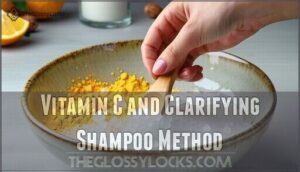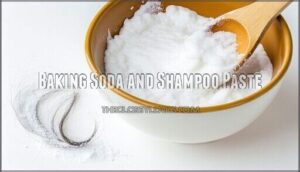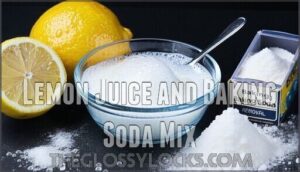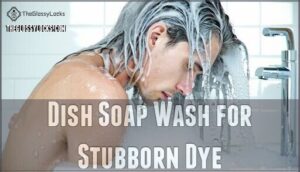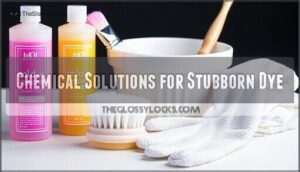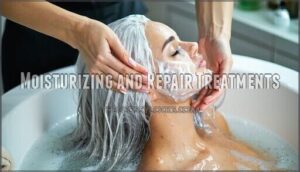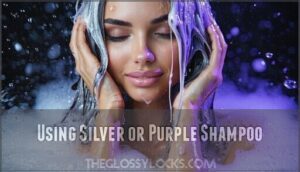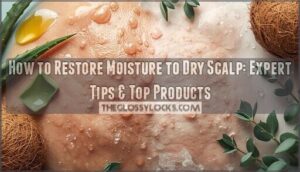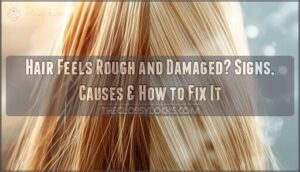This site is supported by our readers. We may earn a commission, at no cost to you, if you purchase through links.
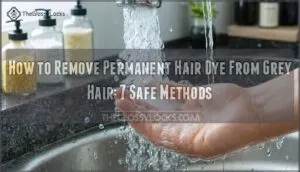
Do a strand test before anything else. Pick a hidden section and try your chosen method there first. Grey hair can react unpredictably to color removal.
Start gentle with vitamin C powder mixed into clarifying shampoo, or make a baking soda paste for stubborn patches. A white vinegar rinse can help break down dye molecules too.
If those don’t work, commercial color strippers are your next step. They’re stronger but effective—just follow the instructions exactly. Your hair will need serious conditioning afterward.
Here’s the thing: take your time. Multiple gentle rounds work better than one aggressive attempt that fries your hair. Prep smart and you’ll get your silver back without the damage.
Table Of Contents
- Key Takeaways
- How to Remove Permanent Hair Dye From Grey Hair
- Natural Methods to Remove Dye From Grey Hair
- Chemical Solutions for Stubborn Dye
- Transitioning From Dyed to Natural Grey Hair
- Caring for Grey Hair After Dye Removal
- Frequently Asked Questions (FAQs)
- Can I use a hair color remover if I have grey hair?
- Is it possible to transition to grey hair without cutting it?
- Is there anything I should avoid when caring for my grey hair?
- How long does dye removal take?
- Can I remove dye without damaging hair?
- Which removal method works fastest?
- How much does dye removal cost?
- Will my original grey color return exactly?
Key Takeaways
- Start with gentle methods first – Try vitamin C powder mixed with clarifying shampoo or baking soda paste before moving to harsh chemical strippers, since grey hair is more fragile than pigmented hair.
- Always test a small section first – Your hair’s porosity and sensitivity can vary, so patch testing prevents disaster and helps you choose the safest removal approach for your specific situation.
- Expect multiple treatments for complete removal – Don’t rush the process with one aggressive session; gradual removal with several gentle treatments protects your hair’s integrity better than harsh chemical blasting.
- Deep condition religiously after each treatment – Grey hair needs extra moisture since it’s naturally drier, so use protein treatments and hydrating masks to restore strength and prevent breakage throughout the removal process.
How to Remove Permanent Hair Dye From Grey Hair
First, figure out what condition your hair is in and what specific type of permanent dye you used before you try removing it.
Knowing your hair’s porosity level and how the chemical bonds from ammonia and hydrogen peroxide work helps you pick the safest removal method that won’t wreck your hair or cause breakage.
Understanding your hair’s porosity level and the chemical bonds formed by ammonia and hydrogen peroxide helps you choose the safest method that won’t cause excessive damage or breakage.
Assessing Hair Health and Dye Type
Before removing permanent dye from grey hair, you’ll need to assess your hair’s current condition. Check your hair porosity by running fingers along wet hair strands – rough texture indicates high porosity from previous chemical treatments. Increased porosity can lead to rapid colour fade.
Examine your scalp condition for irritation or sensitivity. Test strand elasticity by gently stretching a single hair.
Document your dye history and estimate your gray percentage to determine the safest removal approach.
Preparing Hair for Safe Dye Removal
Getting your hair ready for dye removal is crucial if you want to avoid unnecessary damage. First, figure out your hair’s porosity and how elastic your strands are—this tells you which removal approach will work without frying your hair.
- Test a small hidden section first to make sure your scalp won’t react badly
- Use a protective oil treatment beforehand to shield each strand during the process
- Take stock of your hair’s current health—if it’s already damaged, you’ll need to go gentler with removal methods
Doing this prep work right makes all the difference between lifting color successfully and ending up with broken, damaged hair.
Proper hair care preparation makes the difference between successful color lifting and unnecessary breakage.
Protecting Scalp and Hair During The Process
Your scalp needs protection like armor during dye removal. Apply natural oil treatments to create a scalp barrier before starting any permanent hair dye removal process.
Use gentle products that maintain pH balance to prevent hair damage. Keep hydration levels high with deep conditioning treatments.
Choose a mild scalp cleanser afterward for proper hair care and recovery.
Natural Methods to Remove Dye From Grey Hair
Permanent hair dye doesn’t have to be forever on your grey hair. Natural ingredients can gradually break down those color molecules without the harsh chemicals that strip your hair.
These gentler approaches work with your hair’s natural structure instead of against it. They slowly lift the artificial color while keeping your grey strands healthy and strong.
These methods protect your hair’s natural proteins while slowly lifting artificial pigments, making them ideal for delicate grey strands that need extra care.
Vitamin C and Clarifying Shampoo Method
Vitamin C powder mixed with clarifying shampoo creates a gentle yet effective solution for lifting permanent dye from grey hair. This method works by breaking down color molecules without harsh chemicals.
- Mix 1 tablespoon vitamin C powder with 2 tablespoons clarifying shampoo
- Apply to damp hair, focusing on heavily dyed sections
- Leave for 30-60 minutes under a shower cap
- Rinse thoroughly and follow with deep conditioning treatment
Baking Soda and Shampoo Paste
Baking soda effectively penetrates the hair cortex to lift permanent hair dye from grey strands. Mix equal parts baking soda and clarifying shampoo to create a thick paste. Apply this mixture evenly, focusing on heavily dyed sections while monitoring scalp sensitivity.
| Application Step | Method | Safety Tip |
|---|---|---|
| Mix Ratio | 1: 1 baking soda to shampoo | Test pH balance on small section |
| Application | Work paste through damp hair | Avoid scalp if sensitive |
| Processing Time | 5-10 minutes at most | Watch for irritation signs |
| Rinse Method | Cool water first, then warm | Prevents cuticle shock |
| Post-Treatment Care | Deep conditioning mask | Restore moisture immediately |
Vinegar Rinse Technique
White vinegar works by lowering your hair’s pH balance, which helps loosen dye molecules from each strand. This acidic solution makes permanent hair dye removal more effective while promoting hair shine and scalp health.
Here’s how to use this DIY hair color removal method:
- Mix equal parts white vinegar and warm water in a spray bottle
- Apply thoroughly to damp hair, focusing on heavily dyed sections
- Leave on for 15-20 minutes, then rinse with cool water
The vinegar’s odor neutralization properties fade quickly after rinsing. Limit rinse frequency to once weekly to prevent over-processing.
Lemon Juice and Baking Soda Mix
Lemon juice’s citric acid works with baking soda’s alkaline properties to create a powerful DIY dye removal combo.
Mix two tablespoons lemon juice with one tablespoon baking soda into a paste. Apply this mixture to damp hair, focusing on heavily dyed sections. Leave for 20 minutes before rinsing thoroughly.
This acidity-based approach lifts permanent hair dye while being gentler than harsh chemicals.
Dish Soap Wash for Stubborn Dye
If natural methods haven’t worked, dish soap might be your ace in the hole. Dawn or similar grease-cutting formulas can break down stubborn dye molecules.
Mix equal parts dish soap and shampoo, apply to damp hair, and massage gently. Leave for 5-10 minutes before rinsing thoroughly.
This method strips oils aggressively, so deep condition immediately afterward.
Chemical Solutions for Stubborn Dye
If the gentle stuff isn’t cutting it, you’ll need something stronger to actually break apart those dye molecules stuck in your hair.
Just be careful with these stronger products—they pack ammonia or hydrogen peroxide that can fry your hair if you rush in unprepared.
You’ll need to use these stronger formulas carefully since they contain ammonia or hydrogen peroxide, which can damage your hair if you’re not prepared.
Using Hair Dye Strippers Safely
Commercial colour strippers break down permanent dye bonds safely and effectively. You’ll apply the mixture immediately after mixing, then cover your hair with a cap.
Key considerations for safe application:
- Monitor timing precisely – never exceed recommended processing time
- Patch test 48 hours before to avoid allergic reactions
- Ventilate your space well to minimize chemical exposure risks
Professional-grade strippers provide better results but require careful post-stripping care. Many individuals experience hair dye reactions due to ingredients like PPD.
Hydrogen Peroxide and Water Method
Hydrogen peroxide mixed with water creates a gentler alternative when removing hair dye becomes challenging. This DIY approach requires careful peroxide concentration—usually 3% household strength diluted with equal parts water.
Apply the mixture for even saturation, allowing cuticle opening without excessive damage control measures. Monitor processing time closely, then follow with toner application to neutralize brassiness.
Bleach and Shampoo Mixtures
Bleach mixed with shampoo creates a potent solution for permanent hair dye removal, but requires careful mixture ratios to prevent severe damage.
Start with strand testing using one part bleach to three parts clarifying shampoo. Apply this hydrogen peroxide-enhanced mixture to small sections, monitoring for lifting color. Watch processing time closely—overexposure causes breakage.
Follow with deep conditioning and toning afterwards to neutralize brassiness.
Professional Salon Dye Removal
When home remedies fall short, a salon consultation offers professional-grade hair colour rescue service. Your hair stylist will perform a damage assessment and outline treatment costs upfront.
Professional hair dye removal often requires multiple sessions with a maintenance schedule. A salon visit ensures safer chemical application and more predictable expected results than DIY bleaching attempts.
Transitioning From Dyed to Natural Grey Hair
Going back to your natural grey doesn’t mean you need to blast your hair with bleach or other harsh treatments.
There are actually some pretty gentle ways to make the transition that won’t leave your hair feeling like straw.
You don’t need harsh chemicals to switch from dyed hair back to your natural grey color. These gentler methods help you reclaim your silver strands while maintaining hair health and strength.
Letting Hair Grow Out (“Cold Turkey” Method)
One popular approach involves embracing gray hair by stopping permanent hair dye removal completely. Patience is key during this hair changeover process, as new growth creates visible demarcation lines. Here’s what to expect:
- Root growth appears every 4-6 weeks – showing your natural grey hair color
- Demarcation line becomes more pronounced – creating a clear color contrast
- Managing demarcation requires strategic styling – using parts and accessories effectively
- Camouflage options include headbands and scarves – hiding the zone of change temporarily
- Gradual blending occurs over 6-12 months – as more natural hair grows out
This method requires zero chemicals but demands commitment when shifting from dyed hair.
Blending Greys With Highlights or Lowlights
If growing out cold turkey isn’t your speed, blending grey hair with strategic highlights and lowlights creates a softer approach. This technique reduces harsh demarcation lines while your natural grey grows in.
| Highlight Technique | Best For |
|---|---|
| Toning Highlights | Brightening existing grey coverage |
| Cool Ash Placement | Matching natural silver tones |
| Strategic Lowlights | Adding depth to thin grey areas |
Professional lowlight placement every 8-12 weeks maintains blended grey coverage. This damage prevention method requires less maintenance than permanent hair dye while protecting hair integrity during your natural hair color journey.
Big Chop: Cutting Off Dyed Hair
Sometimes drastic situations call for bold solutions. A pixie cut eliminates dyed hair instantly, giving you complete grey hair freedom.
This permanent hair dye removal method offers immediate Style Considerations and a major Confidence Boost. You’ll skip months of awkward Regrowth Expectations while enjoying Maintenance Ease and significant Cost Savings.
Your hair change becomes a statement of self-acceptance, turning from dyed hair into empowerment.
Using Color Depositing Shampoos
Color depositing shampoos offer gradual blending during your gray hair changeover. Purple shampoos provide tone correction by neutralizing yellow undertones in emerging grays.
Apply these products weekly for maintenance routine benefits. Color selection matters—choose ash or silver tones to complement natural grays.
This application frequency prevents harsh lines while supporting permanent hair dye removal efforts through gentle color removal processes.
Caring for Grey Hair After Dye Removal
Your hair’s been through a lot during dye removal, and now it needs focused care to restore strength and maintain your natural grey color.
You’ll want to focus on deep conditioning treatments and specialized grey-friendly products to keep your hair healthy and vibrant.
Moisturizing and Repair Treatments
After removing dye, your hair needs serious TLC. Start with deep conditioning treatments twice weekly using protein treatments to rebuild damaged strands.
Apply hydration masks containing oil infusions to restore moisture balance. Focus on split end repair with targeted hair care treatments.
These hair conditioning steps help reverse chemical damage and prepare your locks for their natural gray journey.
Using Silver or Purple Shampoo
Purple and silver shampoos work wonders for neutralizing undertones in your newly revealed grey hair. These toning effects come from violet pigments that counteract yellow or brassy tones.
Use them once or twice weekly in your maintenance routine, alternating with clarifying shampoo. Check shampoo ingredients for sulfates that might strip color. Proper application frequency prevents over-toning while maintaining your silver hair’s natural beauty.
Minimizing Heat and Chemical Styling
Your hair’s been through enough after permanent hair dye removal. Heat styling damage and chemical overload risks threaten your newly revealed grey strands. Skip the blow dryer when possible and embrace protective styling methods that celebrate your natural texture enhancement.
- Air-dry hair using microfiber towels instead of regular terry cloth
- Set heat tools below 300°F when styling is necessary
- Apply heat protectant sprays before any thermal styling
- Choose gentle product choices without sulfates or harsh alcohols
- Use silk pillowcases to reduce friction and breakage overnight
Diet, Hydration, and Lifestyle Tips
Beyond styling products, your body’s internal health directly impacts grey hair care. Proper nutrient intake—especially iron, copper, and B vitamins—bolsters natural hair treatments and hair growth.
Scalp hydration through adequate water consumption enhances hair treatment effectiveness. Regular exercise benefits circulation to follicles, while quality sleep and stress reduction prevent oxidative damage that accelerates greying.
Frequently Asked Questions (FAQs)
Can I use a hair color remover if I have grey hair?
Before diving into removal methods, know that gray hair responds differently to color strippers.
You can use hair color removers on gray hair, but they’ll work more aggressively since gray strands lack natural pigment protection.
Is it possible to transition to grey hair without cutting it?
Yes, you can shift to grey hair without cutting it. Use highlights, lowlights, or color-depositing shampoos to blend regrowth with existing color, creating a gradual shift over several months.
Is there anything I should avoid when caring for my grey hair?
Avoid harsh sulfates, excessive heat styling, and over-processing treatments. Skip daily washing—grey hair’s naturally drier. Use purple shampoo weekly to prevent yellowing, moisturize regularly, and protect from UV damage.
How long does dye removal take?
Dye removal timing depends on your method. Chemical strippers work in 20-45 minutes, while natural methods like baking soda need multiple treatments over weeks for gradual lightening.
Can I remove dye without damaging hair?
You can minimize damage by using gentle methods like clarifying shampoo, vitamin C treatments, or gradual color fading. Deep condition regularly and avoid harsh chemical strippers.
Which removal method works fastest?
Commercial colour strippers work fastest, removing dye in 20-45 minutes. However, they’re harsh and can damage your hair. Professional salon treatments offer the quickest safe results with proper aftercare.
How much does dye removal cost?
Picture your wallet taking a hit like a sponge soaking up water. Professional dye removal runs $150-400 per hour, while at-home kits cost $5- You’ll likely need multiple sessions for complete removal.
Will my original grey color return exactly?
Your original grey won’t return exactly. Permanent dye damages hair’s natural pigment structures, so you’ll likely see slightly altered tones and textures compared to pre-dye grey.
Getting permanent dye out of grey hair takes time and the right game plan. Try gentler options first—vitamin C treatments or baking soda paste work well—then move up to stronger chemical removers if needed.
Getting permanent dye out of grey hair requires patience and a strategic approach, starting gentle before escalating to stronger methods
Start with a strand test—seriously, don’t skip this step. Your hair’s been through enough already.
Go slow and gentle first, then ramp up if you need to. Whatever route you take, slather on that deep conditioner when you’re done.
Your silver hair will thank you for it.
Always test small sections first and prioritize hair health over speed. Whether you choose natural remedies or professional treatments, deep conditioning afterward keeps your silver strands healthy and vibrant throughout the change process.
- https://pmc.ncbi.nlm.nih.gov/articles/PMC10232955/
- https://katiegoesplatinum.com/gray-hair-statistics/
- https://www.statista.com/statistics/286559/usage-of-hair-coloring-products-in-the-us-trend/
- https://www.reddit.com/r/beauty/comments/147jxdk/im_growing_the_colour_out_of_my_naturally_grey/
- https://dataintelo.com/report/global-consumer-use-light-hair-removal-market

